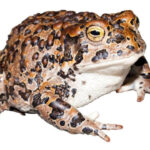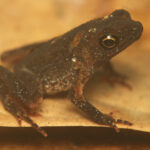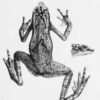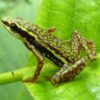- Aromobates meridensis: The Enigmatic Frog of Venezuela's Misty Highlands
- Taxonomy and Classification
- Natural Habitat: A Life Within Cloud-Shrouded Mountains
- Physical Characteristics: Masters of Camouflage in Miniature
- Behavior and Life Cycle
- Ecological Role: Indicators of Forest Ecosystem Health
- Threats and Conservation Status: A Species in Delicate Balance
- Cultural and Scientific Significance of Aromobates meridensis
- Conclusion: Cherishing a Tiny Amphibian with a Big Ecological Message
Aromobates meridensis: The Enigmatic Frog of Venezuela’s Misty Highlands#
Beneath the lush understory of Venezuela’s Andean cloud forests, hidden among moss-draped stones and rushing mountain streams, lives an extraordinary yet little-known amphibian species—Aromobates meridensis. Known colloquially as the Mérida rocket frog, this diminutive creature blends seamlessly into the vibrant greenery, quietly carrying out its role within one of the world’s most distinctive ecosystems. Though easily overlooked by the casual observer, it stands as a vital, living symbol of the delicate equilibrium existing within these mist-enveloped highlands.
Measuring scarcely over an inch in length, Aromobates meridensis commands attention not for its size but for an intriguing evolutionary history and an array of unique adaptations to its mountainous environment. It is a species whose journey through evolutionary time, ecological function, and mounting conservation concerns provide a compelling narrative worthy of exploration. Join us as we step softly through its cloud forest home, unveiling the colorful details of this small amphibian’s captivating existence.
Taxonomy and Classification#
To truly understand the Mérida rocket frog, we first delve into its biological identity. Scientifically classified in the family Aromobatidae, alongside fellow poison and dart frogs, Aromobates meridensis lacks the potent toxins commonly associated with its more famous relatives. The genus Aromobates comprises several endemic species adapted uniquely to the mountainous habitats of Venezuela and its neighboring ecosystems, each carving out specialized ecological niches amid challenging topographies.
Described formally by Dole and Durant in 1972, Aromobates meridensis owes its specific epithet “meridensis” to its namesake habitat in Venezuela’s Mérida state. Close relatives like Aromobates nocturnus and Aromobates mayorgai share overlapping ranges and habitats, providing researchers insight into the evolutionary paths these frogs undertook within the Andean region. Still, distinct physiological and behavioral differences separate these species, facilitating a fascinating comparison within a relatively narrow geographical locality.
Natural Habitat: A Life Within Cloud-Shrouded Mountains#
The Mérida rocket frog finds its humble kingdom within the misty montane forests of the Venezuelan Andes, particularly concentrated in the Cordillera de Mérida. Here, the climate is characterized by almost perennial fog, cooler temperatures, and abundant rainfall—conditions ideally suited to amphibians that rely heavily on consistent moisture and stable temperatures. From elevations of approximately 1,600 meters upwards, these frogs thrive in pristine, moist habitats dominated by dense foliage, shaded leaf litter, moss-covered rocks, and clear mountain streams.
One can imagine walking softly in this enchanted landscape, the air thick with moisture, wrapped in a perpetual cool fog that shrouds towering trees adorned with bromeliads, moss, and dense ferns. It is here, nestled in damp leaf litter or near trickling streams, that Aromobates meridensis makes its home. They are often found near hydrographic networks—crystal clear alpine streams and small watercourses serving as critical breeding sites. Their nightly chorus blends subtly into the ambient sounds of dripping leaves, flowing water, and nearby insects, rendering the frogs’ whereabouts elusive to passing hikers or researchers alike.
This highly specialized habitat offers an excellent vantage from which to recognize conservation significance. Climatic stability, microhabitat specialization, and limited dispersal capacity tether these frogs to very small geographic ranges, underscoring both their extraordinary adaptation and their vulnerability.
Physical Characteristics: Masters of Camouflage in Miniature#
At first glance, the beauty of Aromobates meridensis may go unnoticed due to its subtle camouflage. Typically measuring around 20–25 millimeters, these frogs embody subtle elegance, their streamlined forms adapted for both rapid movement and efficient concealment. Coloration is muted yet intricate, blending seamlessly into their mossy and decayed-leaf surroundings, displaying hues ranging from soft olive greens and browns to variants of grey and orangish browns, often shimmering slightly under filtered forest light.
Closer scrutiny reveals finer details: intricate patterns and markings across their back and legs, some specimens bearing faint dorsal stripes, others sporting dappled patterns thoughtfully imitating miniature landscapes of lichen and moss. The skin texture, smooth but moist, aids in hydration and respiratory exchange, crucial adaptations at mountainous elevations where ambient air is both cooler and moister, requiring precise control over moisture balance.
Their strong hind limbs allow swift jumps that earn them their “rocket frog” moniker, an adaptation vital for swift escapes from predators or quick movements between vegetation patches. Though seemingly frail, their small, delicate build conceals remarkable resilience, essential for survival within an environment both lush yet harsh.
Behavior and Life Cycle#
A Life of Quiet Precision#
Behaviorally, Aromobates meridensis exemplifies quiet refinement rather than showy display. Primarily active during humid dawn hours and evenings, their movements are precise and cautious. Their dietary choices revolve primarily around small invertebrates abundant in these ecosystems, including ants, small beetle larvae, mites, and tiny forest insects. Employing patient ambush tactics under sheltering leaves or logs, these frogs capitalize on swift, precision hopping to seize prey opportunistically.
Intricate Breeding Rituals and Parental Dedication#
Perhaps the most engaging aspect of Mérida rocket frog biology revolves around its reproductive behavior. During rainy seasons, males establish discreet territorial claims near streams or moisture-rich environments, softly vocalizing at dawn or dusk to attract females. Their calls—a gentle series of chirping notes—are subtle yet effective, perfectly suited to an environment where loud noises may draw unwanted attention from predators.
Uniquely, breeding does not occur within water bodies directly, but eggs are laid within damp leaf packets or moist leaf litter nearby the streams. Females carefully deposit small clusters of eggs, typically fewer than twenty, and unlike many amphibians that leave eggs unguarded, these frogs exhibit commendable parental dedication. The male guards the eggs zealously, occasionally moistening them and warding off potential egg predators such as various ants, beetles, or fungus.
Tadpoles hatch as tiny, energetic creatures that wiggle into surrounding freshwater bodies or narrow trickles, developing quickly in these nutrient-rich streams. Development periods remarkably coincide with the region’s seasonal rainfall, ensuring tadpoles mature into miniature froglets within a few weeks, perfectly synchronized to abundant food and favorable habitat conditions.
Ecological Role: Indicators of Forest Ecosystem Health#
Aromobates meridensis plays a pivotal ecological role as both predator to forest-floor insects and prey to snakes, birds, and larger amphibians. As part of complex food webs, they help regulate insect populations, subsequently influencing larger predator species reliant indirectly on amphibian-driven insect control.
Critically, as amphibians, their highly permeable skin renders them sensitive bioindicators of ecosystem health. Changes in their populations may reflect emerging threats like pollution, subtle climate variations altering rainfall and temperature patterns, or habitat degradation—alerting conservationists to problems long before other visible environmental changes initially present themselves.
Threats and Conservation Status: A Species in Delicate Balance#
The Mérida rocket frog currently finds itself classified by the International Union for Conservation of Nature (IUCN) as Endangered. Habitat loss from agriculture, deforestation, and urban expansion threatens to fragment their already limited habitat severely. Moreover, climate change disrupts rainfall patterns critical to their intricate breeding timing, posing further challenges for long-term survival.
Fortunately, regional initiatives in habitat conservation, biodiversity monitoring programs, and educational outreach are beginning to raise awareness about the fragility and value of these amphibians. National park boundaries within Venezuela’s protected systems aid in securing vital habitats, highlighting the importance of such reserves in the longer-term survival strategy of this delicate species.
Cultural and Scientific Significance of Aromobates meridensis#
While the Mérida rocket frog remains relatively obscure in broader culture, it substantially contributes scientifically to our understanding of biodiversity, evolution in isolation, and mountain ecosystem dynamics. Studies into their reproductive strategies, physiological tolerance, and habitat requirements offer critical insights applicable to broader amphibian conservation strategies globally, making them invaluable subjects for future scientific inquiry.
Conclusion: Cherishing a Tiny Amphibian with a Big Ecological Message#
The quietly remarkable Aromobates meridensis has much to teach us—not only about the complexities of mountain ecosystems but about ourselves as stewards of biodiversity. It embodies resilience, adaptation, and delicate reliance on environmental balance. By understanding its life, we become better custodians of the intricate worlds in which these amphibians dwell. Let us remain passionately curious, actively committed, and deeply moved to preserve the delightful and vulnerable realms inhabited by this special creature.













